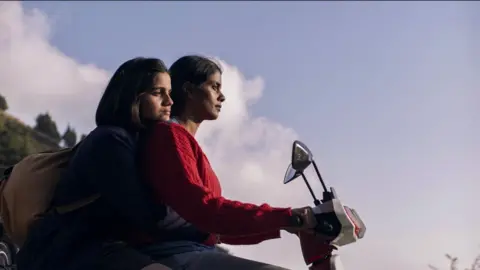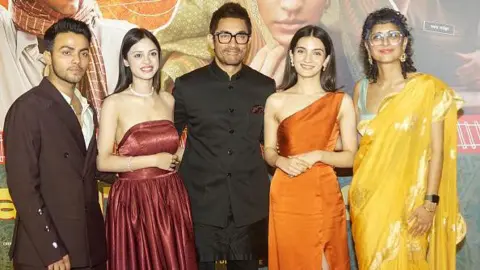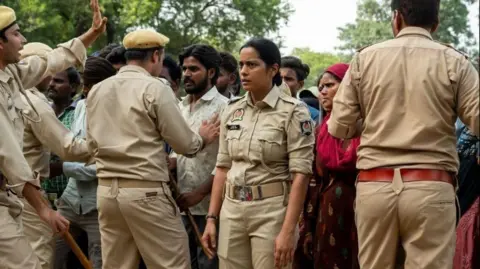
 Getty Images
Getty ImagesIn 2024, as Bollywood struggled to find its footing, smaller films by Indian women that told nuanced stories made headlines in the country and across the world.
In May, Indian filmmaker Payal Kapadia’s All We Imagine As Light made history by winning the Grand Prix at the Cannes film festival.
In the months since then, All We Imagine As Light has become a juggernaut of indie cinema, sweeping through film festivals and the awards circuit. It has been judged the Best International film by prestigious associations including the New York Film Critics Circle and the Toronto Film Critics Association. It has also picked up two Golden Globe nominations, including for Ms Kapadia as best director.
It is also on several best films of the year list, including that of the BBC and the New York Times.
And it has company.
Director Shuchi Talati’s coming-of-age drama Girls Will Be Girls won two awards at the Sundance Film Festival. Kiran Rao’s Laapataa Ladies (Lost Ladies) spent at least two months on the top 10 list of Netflix in India and was picked as the country’s official Oscar entry (a controversial decision). Laapataa Ladies didn’t make it to the Academy’s shortlist. What did make it was British-Indian director Sandhya Suri’s Hindi film Santosh, which had been picked as the UK’s submission to the Oscars.
Is this sudden wave of success for Indian films an aberration or a long-awaited shift in global consciousness?
“It’s a culmination of both,” says film critic Shubhra Gupta, pointing out that these films were not “made overnight”.
For instance, Shuchi Talati, the director of Girls Will Be Girls, and its co-producer Richa Chadha were in college together when they first came up with the idea for the film. “They have been working on it for years,” Gupta says.
“It’s pure serendipity that 2024 became the year these films were released, igniting conversations together.”
 Girls Will Be Girls
Girls Will Be GirlsThis fortunate alignment has been a cinematic dream. The global impact of these films is rooted in their quality and exploration of universal themes like loneliness, relationships, identity, gender and resilience. With strong female voices and unconventional feminist narratives, these stories venture into territories unexplored by mainstream Indian cinema.
In All We Imagine As Light, a film made in the Hindi, Marathi and Malayalam languages, three migrant women in Mumbai navigate empathy, resilience and human connection. The narrative delves into themes of loneliness and the socio-political landscape, notably the scrutiny of interfaith Hindu-Muslim relationships as seen with the character Anu (Divya Prabha) and her bond with Shiaz (Hridhu Haroon).
Kapadia told the BBC that while the women in her films are financially independent, they still face limitations in their personal lives, particularly when it comes to matters of love.
“For me, love in India is very political… women seem to hold a lot of the so-called honour of the family and the protection of the caste lineage. So if she marries somebody who is of a different religion or of a different caste, that becomes an issue. For me, it is really a method to control women and infantilise them,” she says.
Talati’s Girls Will Be Girls explores female adolescence, rebellion and intergenerational conflict through the story of a 16-year-old girl studying at a strict boarding school in the Himalayas and her fractured relationship with her mother, Anila, who struggles with her own vulnerabilities and unresolved emotions.
“It is the kind of coming-of-age film that we don’t do in India at all,” Gupta says. “It looks at women from a very empathetic, very warm gaze.”
“The age where people experience emotions with and without their bodies, their minds, that exploration but without infantilising the experience – it was never part of Indian mainstream cinema,” she adds.
 Getty Images
Getty ImagesKiran Rao’s Laapataa Ladies did not perform well at the box-office but got warm reviews from viewers and critics. At a BAFTA screening in London this month, Ms Rao described the current moment as “really special for women from India”, expressing hope for a continued wave of such stories.
Her film is a satirical comedy about two newlywed brides getting accidentally swapped on a train because of their veils. It offers a sharp commentary on patriarchy, identity and gender roles, a shift from decades of male-centred mainstream Indian films.
“A lot of us who are very patriarchal in our thinking are often that way because that’s how we have been brought up,” Bollywood star Aamir Khan, a co-producer of the film, said after the screening. “But we need to be understanding, at least try and help each other even to come out of this kind of thinking.”
The biggest surprise this year came from the UK, which selected the Hindi-language film Santosh, directed by British-Indian filmmaker Sandhya Suri, as its Oscar entry. Shot entirely in India over a 44-day schedule, it featured a largely female crew. Starring Indian actors Shahana Goswami and Sunita Rajbhar, Santosh was co-produced by people and companies across the UK, India, Germany and France.
The film is intrinsically an Indian story about violence against women, set as a taut thriller.
Goswami says the success of Santosh and All We Imagine as Light points to the merging of borders and expansion of film industries, creating space for cross-pollination and exchange.
“We often think these Indian films require [specific] cultural context, but they don’t. Any film driven by emotion will resonate universally, regardless of its origins,” she told the BBC.
 Santosh
SantoshThree of the films – All We Imagine as Light, Girls Will Be Girls and Santosh – share one more common trait: they are cross-country co-productions.
Goswami agrees that this could this be a formula for the future.
“With a French producer, for example, a film gains the opportunity to be seen by a French audience who may follow that producer or the broader film industry. This is how it becomes more globally accessible and relevant,” she says.
Even in Bollywood, some women-led films have had huge success this year. Stree 2, a horror-comedy about a mysterious woman battling a monster who abducts free-thinking women, was the year’s second-biggest hit, playing in cinemas for months.
On streaming platforms, Sanjay Leela Bhansali’s opulent Netflix series Heeramandi: The Diamond Bazaar, an exploration of the misogyny and exploitation in the lives of courtesans in pre-independent India, was among Google’s top-searched TV shows of the year.
Their success seems to signal a growing appetite for such stories, their broad appeal demonstrating that mainstream cinema can address important themes without sacrificing entertainment value.
Despite systemic challenges, 2024 has highlighted the global power of female voices from India and the demand for diverse stories. The momentum could be crucial for the Indian film industry in getting wider distribution for its independent films and pave the way for a more diverse and equitable film landscape.



Be the first to comment